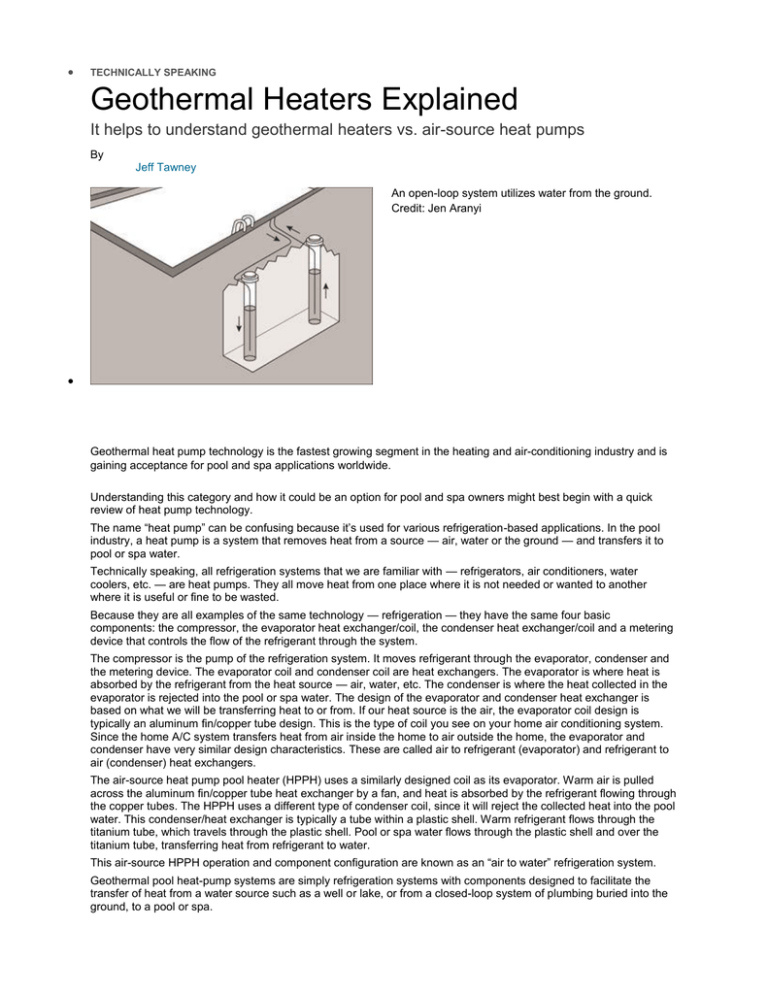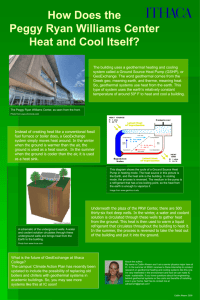Geothermal Heaters Explained
advertisement

TECHNICALLY SPEAKING Geothermal Heaters Explained It helps to understand geothermal heaters vs. air-source heat pumps By Jeff Tawney An open-loop system utilizes water from the ground. Credit: Jen Aranyi Geothermal heat pump technology is the fastest growing segment in the heating and air-conditioning industry and is gaining acceptance for pool and spa applications worldwide. Understanding this category and how it could be an option for pool and spa owners might best begin with a quick review of heat pump technology. The name “heat pump” can be confusing because it’s used for various refrigeration-based applications. In the pool industry, a heat pump is a system that removes heat from a source — air, water or the ground — and transfers it to pool or spa water. Technically speaking, all refrigeration systems that we are familiar with — refrigerators, air conditioners, water coolers, etc. — are heat pumps. They all move heat from one place where it is not needed or wanted to another where it is useful or fine to be wasted. Because they are all examples of the same technology — refrigeration — they have the same four basic components: the compressor, the evaporator heat exchanger/coil, the condenser heat exchanger/coil and a metering device that controls the flow of the refrigerant through the system. The compressor is the pump of the refrigeration system. It moves refrigerant through the evaporator, condenser and the metering device. The evaporator coil and condenser coil are heat exchangers. The evaporator is where heat is absorbed by the refrigerant from the heat source — air, water, etc. The condenser is where the heat collected in the evaporator is rejected into the pool or spa water. The design of the evaporator and condenser heat exchanger is based on what we will be transferring heat to or from. If our heat source is the air, the evaporator coil design is typically an aluminum fin/copper tube design. This is the type of coil you see on your home air conditioning system. Since the home A/C system transfers heat from air inside the home to air outside the home, the evaporator and condenser have very similar design characteristics. These are called air to refrigerant (evaporator) and refrigerant to air (condenser) heat exchangers. The air-source heat pump pool heater (HPPH) uses a similarly designed coil as its evaporator. Warm air is pulled across the aluminum fin/copper tube heat exchanger by a fan, and heat is absorbed by the refrigerant flowing through the copper tubes. The HPPH uses a different type of condenser coil, since it will reject the collected heat into the pool water. This condenser/heat exchanger is typically a tube within a plastic shell. Warm refrigerant flows through the titanium tube, which travels through the plastic shell. Pool or spa water flows through the plastic shell and over the titanium tube, transferring heat from refrigerant to water. This air-source HPPH operation and component configuration are known as an “air to water” refrigeration system. Geothermal pool heat-pump systems are simply refrigeration systems with components designed to facilitate the transfer of heat from a water source such as a well or lake, or from a closed-loop system of plumbing buried into the ground, to a pool or spa. A closed-loop system circulates water through pipes, absorbing heat. Credit: Jen Aranyi The geothermal system is becoming popular based on its reliable heat source. Ground temperatures and water are constant and much warmer than the air above. It has been designated a “renewable heat source” by the U.S. Department of Energy. With an air-source heat pump, heat is drawn from the outside air. Naturally, as the air cools, there is less heat available, causing the capacity, or Btus per hour, to decrease. The efficiency rate, called the coefficient of performance (COP), also falls with decreasing air temperatures. Even with air temperatures as low as 40- to 50°F, an effective transfer of heat is possible and efficiencies typically remain higher than other heating systems, except geothermal. Geothermal, or water-to-water systems, depend on a much more stable heat source. Temperature fluctuations in any given water source — lake, river, ground loop or especially, a well — are much less, resulting in more stable and predictable temperatures. A properly designed heat pump, using one of these water sources, can deliver very efficient and reliable operation with little variance in its capacity or efficiency. A comparative example would be: A typical air source HPPH operating at 75 degrees may be rated at 100,000 Btu per hour with a COP of 6.0. This same HPPH, operating at 50 degree air temperature is rated at 65,000 Btu per hour with a COP of 4.0. The lower temperature results in an approximate drop of 35 percent in capacity and efficiency. Proper sizing of the HPPH to the desired pool takes this into account, and the air source HPPH remains a very effective and efficient means of heating pools in mild climate conditions. A typical water source or geothermal HPPH, utilizing a well at 60 degrees may also be rated at 100,000 Btu per hour and a COP, adjusted for well pumping costs, of 5.5. The key difference is that the geothermal unit will always operate at those conditions. Well water will come out of the ground at the same temperature — winter, summer, fall or spring. This is called an “open loop” system, where water is pumped from the ground, supplied to the heat pump for heat removal and the slightly chilled water is returned via a discharge well back to the ground. The geothermal heat pump is approximately the same cost per Btu as its air source cousin. The loop system, whether open (well) or closed (buried pipe), is an added expense compared to the air-source heat pump. However, the extra reliability and efficiency often deliver a very reasonable payback period. Because these units do not depend on air flow for heat, they are totally enclosed and virtually silent and can be installed anywhere, indoors or out. Due to the application and operational parameters, an additional 50 percent life expectancy can be counted on for this type of equipment versus air source heat pumps. One creative application of this type of equipment uses an unheated pool as a source for the heat pump. This application transfers heat from the pool via the heat pump, to a spa. While not technically a geothermal application, the pool water has plenty of heat available even down to water temperatures of 45 degrees. This application features reliable spa heating at a fraction of the cost of gas spa heating systems. Tawney is vice president of AquaCal AutoPilot Manufacturing in St. Petersburg, Fla. He is a 34-year industry veteran and a licensed HVAC contractor.


